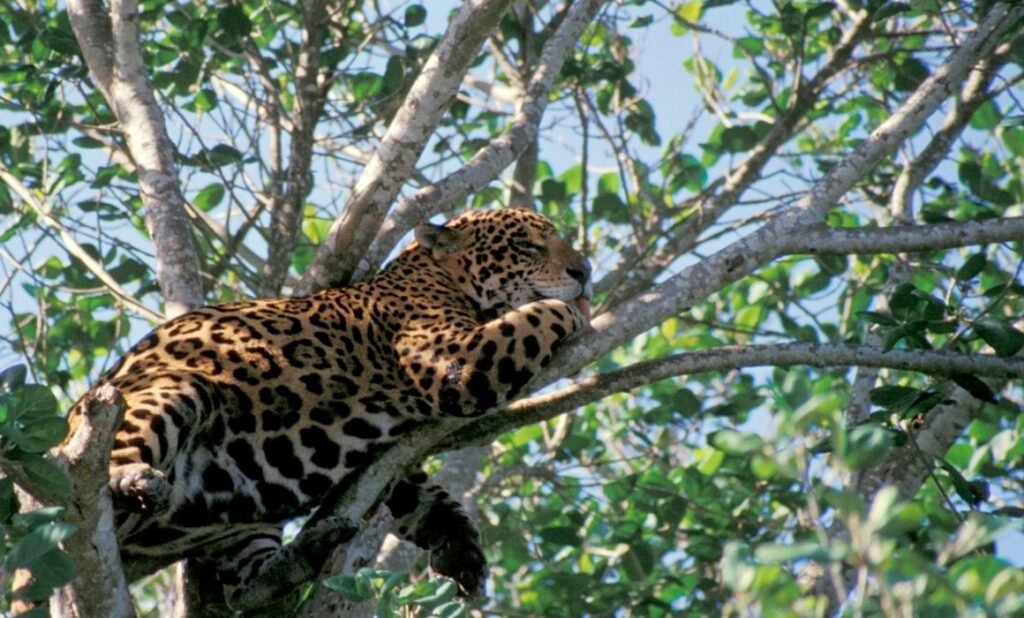The Mexican jaguar, an emblematic species of the Americas, is under severe threat due to habitat loss, urban expansion, and human activity. More than half of Mexico’s jaguar population resides in the Yucatán Peninsula, but deforestation and infrastructure development are fragmenting their territory, pushing the species closer to extinction.
A Species Under Siege
Reina and Chamaco, a mother jaguar and her cub, were captured on camera in January 2019 by the Jaguar Wildlife Center (JWC), an organization dedicated to environmental education and wildlife monitoring in Quintana Roo. Their brief moment of interaction—vocalizing to each other in the dense jungle—was one of the last recorded before Reina was struck and killed by a vehicle on Federal Highway 307, near the now-defunct Calica mining site.
Her death was not an isolated incident. Between 2019 and 2024, at least six jaguars were killed in collisions along the same highway, including Xen, a lactating female, and Naku, a pregnant jaguar. Some carcasses were later found mutilated, likely for illegal trade.
Deforestation and Habitat Fragmentation
The primary threat to jaguars is the rapid loss of their habitat. From 2019 to 2023, Quintana Roo lost 58,319 hectares of primary forest—a quarter of the deforestation recorded over the past two decades. The expansion of tourism, real estate, and infrastructure projects, including highways and the Tren Maya, has further fragmented the jaguar’s territory.
Raúl Padilla, president of JWC, emphasizes the need for biological corridors to connect fragmented habitats. “Jaguars don’t cross roads—roads cross their habitat,” he says. The National Alliance for Jaguar Conservation has identified 12 critical corridors in Mexico, with 37% located in the Yucatán Peninsula. However, urban development continues to encroach on these vital pathways.

Conservation Efforts and Challenges
In September 2024, the former Calica mining site was declared a protected natural area, adding 1,200 hectares to the Felipe Carrillo Puerto Flora and Fauna Protection Area. While this move is a step forward, experts argue that more political will is needed to establish and maintain biological corridors.
Rodrigo Medellín, a leading ecologist from UNAM, warns that existing protected areas, such as the newly established Jaguar National Park in Tulum, are insufficient. “A female jaguar’s home range can exceed 200 square kilometers, but this park covers only 29.13 square kilometers—and it’s divided,” he explains.
The Fight for Survival
Jaguars in Mexico face additional threats, including illegal hunting and human-wildlife conflict. A 2024 WWF report highlights that retaliatory killings by ranchers, subsistence hunting, and competition for resources contribute to the species’ decline.
Despite these challenges, conservationists like Padilla remain committed. “A jaguar should die of old age, not on a highway,” he says. Efforts to mitigate damage from infrastructure projects, such as removing fencing along the Tren Maya route and installing wildlife crossings, offer a glimmer of hope.
The Future of the Jaguar
With over 60% of their historic range lost in the last 40 years, the survival of Mexico’s jaguars hinges on urgent conservation measures. Protecting remaining forests, enforcing anti-poaching laws, and expanding biological corridors are critical to ensuring that these majestic predators continue to roam the jungles of the Yucatán.
As Padilla reflects on his first encounter with a wild jaguar in 2010, he remains hopeful: “Conserving these forests means giving them a chance to survive.” The question remains whether human development will leave enough space for the jaguar to thrive—or if the species will vanish from Mexico’s wilderness forever.
Discover more from Riviera Maya News & Events
Subscribe to get the latest posts sent to your email.
